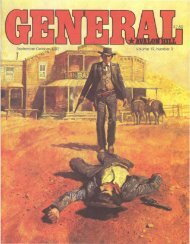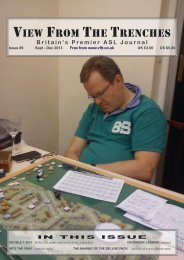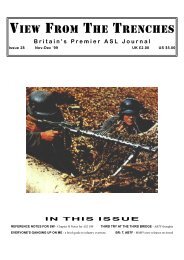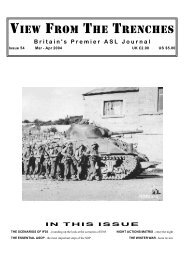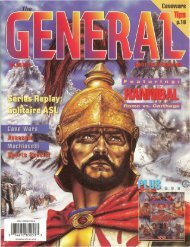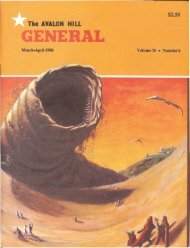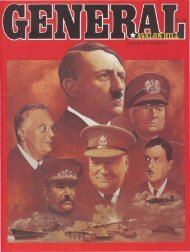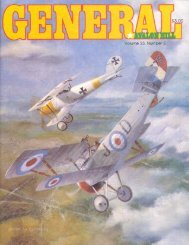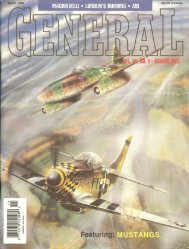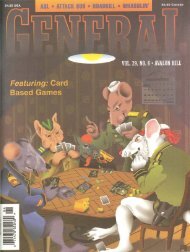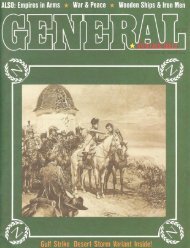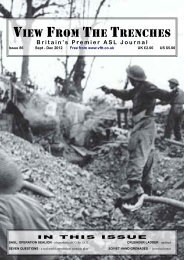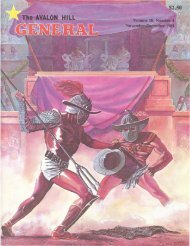Create successful ePaper yourself
Turn your PDF publications into a flip-book with our unique Google optimized e-Paper software.
I<br />
m<br />
a<br />
Table 1<br />
Reinfopcement rrnd Repkement Factors<br />
German Rtlssian<br />
<strong>No</strong>vlDec - 47 47<br />
10 -<br />
Total 1944 1 59 60 282 282<br />
*: Archangel die roll stam; assume average die roll of 3<br />
": Estimated maximum.<br />
***: Replacement factor rate doubles.<br />
Table 2<br />
Worker Units: Hypothetical Piay<br />
Number of Factors<br />
Total<br />
dded ' leatir- Destroved Location Remhim Eh.<br />
-<br />
Total 1941 12 6<br />
<strong>No</strong>vlDec - - - 7 192<br />
Total 1943 1 5 7 192<br />
tance has already been discussed. To the east lie two<br />
major cities: Gorki and Saratov, both likely homes<br />
for worker units. To the south are more major cities:<br />
Stalingrad and Rostov. Even farther south are the<br />
oil fields of the Caucasus Mountains; another<br />
worker unit can be expected in Astrakhan.<br />
If the German has lost two or more armored units<br />
on the drive to Voronezh and there are workers re-<br />
maining anywhere on the steppes, then a drive south<br />
may be the way to go. On the other hand, if the<br />
German has planned his attacks well and has had<br />
good die rolls, he will not need the additional oil<br />
wells. <strong>The</strong> Russian player may have reacted to the<br />
drive through the steppes and placed worker units<br />
farther north in Tula and Kalinin. If so, then it is<br />
time to consider turning to the north for the knock-<br />
out punch.<br />
As stated above, the situation will dictate what<br />
to do next; however, one thing that the Gennan must<br />
understand is that this is an eitherlor decision. He<br />
will have neither sufficient forces nor time to mount<br />
two separate drives in opposite directions. Besides<br />
being in a central position at Voronezh, the other<br />
factor still allowing him the offensive initiative is<br />
the concentration of power to break through at will,<br />
with the aid of Stukas of course. He should never<br />
dilute this strategic advantage by splitting his own<br />
forces after having accomplished the same against<br />
his opponent.<br />
Having outlined the "Steppes strategy" above,<br />
what numerical impact can it have on the game?<br />
How many worker units will be eliminated? Table<br />
2 attempts to demonstrate the effect of this strategy.<br />
<strong>The</strong> placement of workers reflects the likely Russian<br />
reaction to a thrust by panzers through the steppes.<br />
Worker units worth "2" are placed to the extreme<br />
north and south. Lesser worker units are first placed<br />
in major cities, and then in minor ones. Worker units<br />
destroyed in the table follow the pattern outlined<br />
here, with a final push in 1943 aimed at Moscow.<br />
<strong>The</strong> conclusion from Table 2 is not that 15 worker<br />
units could be destroyed by the end of 1943. Much<br />
more important is the ripple effect of worker units<br />
destroyed early in the game (i.e., the cumulative<br />
total number of factors eliminated from play). By<br />
way of example, say that Kiev is cleared in JulIAug<br />
1941; two factors are lost not only that turn, but<br />
every turn thereafter. A total of 38 factors removed<br />
from the Russian for the destruction of one worker<br />
unit! And remember the rate is doubled beginning<br />
MaylJune 1943. <strong>The</strong> right-hand column tells the<br />
complete story: a successful Steppes strategy can<br />
eliminate 192 replacement factors through 1943.<br />
That is the equvalent of 35 to 45 armies!<br />
Conclusion<br />
<strong>The</strong> German player in THE RUSSIAN CAM-<br />
PAIGN cannot make the same mistakes as his histor-<br />
ical counterparts and expect to win. Hitler and the<br />
OKW staff wanted to make drives to the extreme<br />
south and north when they invaded Russia. Halder<br />
and the OKH staff lobbied for a single thrust in the<br />
center towards Moscow. What resulted was a com-<br />
promise. "In a real sense, it can be said that the<br />
German Army had no strategic guidance in 1941. "<br />
(Bryan Fugate, Operation hrbarossa, pg. 301)<br />
Germany was unable to concentrate sufficient forces<br />
for a strategic victory in 194 1. In TRC, the German<br />
player must develop a centralized strategy and<br />
aggressively pursue it while minimizing his losses.<br />
Russian worker units must be taken into account in<br />
the mathematics of the campaign. Otherwise, history<br />
is likely to be repeated. *



